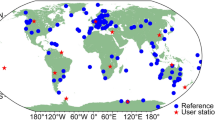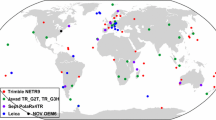Abstract
Currently, four GLONASS-M+ satellites and two GLONASS-K1 satellites transmit CDMA signals on the G3 frequency. It is important to understand the inconsistency between the new G3 and traditional FDMA G1 and G2 signals, wherein inter-frequency clock bias (IFCB) is one of the important indexes to find the difference of triple-frequency carrier phase hardware delays. Using the geometry-free and ionospheric-free (GFIF) phase combinations and an epoch-differenced method, we use 152 globally distributed MGEX stations spanning 30 days to estimate GLONASS IFCB. GLONASS-K1 satellite R09 and GLONASS-M+ satellite R21 are selected for analysis in the experiment owing to enough G3 observations. Results indicate that the magnitudes of the multipath error and SNR on G3 frequency are noticeably smaller than those of the other two frequencies. A satellite-induced multipath error seems to exist on the G3 frequency of R21, whereas R09 has none, which needs to be quantized and modeled further. The intra-day peak-peak amplitudes of R09 and R21 IFCBs are about 0.01 and 0.2 m, while inter-day amplitudes are about 0.03 and 0.3 m, respectively; R21 is even larger than that of GPS Block-IIF satellites (about 0.2 m). The RMS and STD of the IFCB series of R09 and R21 are 0.90, 0.89 cm, and 10.56, 10.53 cm, respectively. Therefore, the IFCB errors must be carefully corrected in GLONASS G3-frequency applications. Fortunately, the IFCBs of R21 present both intra-day and inter-day sine-wave periodic variations, which may be modeled, and even well predicted in the future.







Similar content being viewed by others
Data availability
GNSS observation data are provided by Multi-GNSS Experiment (MGEX) setup by IGS. Data from MGEX are released by Institut Geographique National (IGN) that can be accessed from ftp://igs.ign.fr/pub/igs/data/campaign/mgex/daily/rinex3 and released by Bundesamt für Kartographie und Geodäsie (BKG) can be accessed from ftp://igs.bkg.bund.de/IGS/obs.
References
Deo M, El-Mowafy A (2016) Triple-frequency GNSS models for PPP with float ambiguity estimation: performance comparison using GPS. Surv Rev 50(360):249–261
Elsobeiey M (2015) Precise point positioning using triple-frequency GPS measurements. J Navig 68(3):480–492
Fan L, Shi C, Li M, Wang C, Zheng F, **g G, Zhang J (2019) GPS satellite inter-frequency clock bias estimation using triple-frequency raw observations. J Geod 93(12):2465–2479
Geng J, Guo J, Meng X, Gao K (2020) Speeding up PPP ambiguity resolution using triple-frequency GPS/BeiDou/Galileo/QZSS data. J Geod 94(1):1–15
Guo J, Geng J (2018) GPS satellite clock determination in case of inter-frequency clock biases for triple-frequency precise point positioning. J Geod 92(10):1133–1142
Li H, Zhou X, Wu B, Wang J (2012) Estimation of the inter-frequency clock bias for the satellites of PRN25 and PRN01. Sci China Phys, Mech Astron 55(11):2186–2193
Li H, Li B, **ao G, Wang J, Xu T (2015) Improved method for estimating the inter-frequency satellite clock bias of triple-frequency GPS. GPS Solut 20(4):751–760
Li X, Liu G, Li X, Zhou F, Feng G, Yuan Y, Zhang K (2019) Galileo PPP rapid ambiguity resolution with five-frequency observations. GPS Solut 24(1):24
Montenbruck O, Hugentobler U, Dach R, Steigenberger P, Hauschild A (2012) Apparent clock variations of the Block IIF-1 (SVN62) GPS satellite. GPS Solut 16(3):303–313
Montenbruck O, Hauschild A, Steigenberger P (2014) Differential code bias estimation using muti-GNSS observations and global ionosphere maps. Navigation 61:191–201
Montenbruck O, Steigenberger P, Prange L, Deng Z, Zhao Q, Perosanz F, Romero I, Noll C, Stürze A, Weber G (2017) The multi-GNSS experiment (MGEX) of the international GNSS service (IGS) – achievements. Prosp Chall, Adv Space Res 59(7):1671–1697
Pan L, Li X, Zhang X (2017a) Considering inter-frequency clock bias for bds triple-frequency precise point positioning. Remote Sens 9(7):734
Pan L, Zhang X, Li X, Liu J, Li X (2017b) Characteristics of inter-frequency clock bias for Block IIF satellites and its effect on triple-frequency GPS precise point positioning. GPS Solut 21(2):811–822
Pan L, Zhang X, Li X, Liu J, Guo F, Yuan Y (2018) GPS inter-frequency clock bias modeling and prediction for real-time precise point positioning. GPS Solut 22(3):1–5
Pan L, Zhang X, Guo F, Liu J (2019) GPS inter-frequency clock bias estimation for both uncombined and ionospheric-free combined triple-frequency precise point positioning. J Geod 93(4):473–487
Pan L, Jiang X, Zhang X, Ge M, Schuh H (2020) GPS + Galileo + BeiDou precise point positioning with triple-frequency ambiguity resolution. GPS Solut 24(3):L07304-L7543
Wang N, Yuan Y, Li Z, Montenbruck O, Tan B (2015) Determination of differential code biases with multi-GNSS observations. J Geod 90(3):209–228
Wanninger L (2011) Carrier-phase inter-frequency biases of GLONASS receivers. J Geod 86(2):139–148
Wanninger L, Beer S (2015) BeiDou satellite-induced code pseudorange variations: diagnosis and therapy. GPS Solut 19(4):639–648
Zaminpardaz S, Teunissen PJG, Nadarajah N (2017) GLONASS CDMA L3 ambiguity resolution and positioning. GPS Solut 21(2):535–549
Zaminpardaz S, Teunissen PJG, Khodabandeh A (2021) GLONASS–only FDMA+CDMA RTK: performance and outlook. GPS Solut 25(3):1–12
Zhang F, Chai H, Li L, **ao G, Du Z (2021) Estimation and analysis of GPS inter-frequency clock biases from long-term triple-frequency observations. GPS Solut 25(4):126
Acknowledgements
Thanks to MGEX for offering observation data. This study was supported by the National Natural Science Foundation of China (42074014, 42104033).
Author information
Authors and Affiliations
Corresponding author
Additional information
Publisher's Note
Springer Nature remains neutral with regard to jurisdictional claims in published maps and institutional affiliations.
Rights and permissions
About this article
Cite this article
Zhang, F., Chai, H., Li, L. et al. Understanding the characteristic of GLONASS inter-frequency clock bias using both FDMA and CDMA signals. GPS Solut 26, 63 (2022). https://doi.org/10.1007/s10291-022-01249-9
Received:
Accepted:
Published:
DOI: https://doi.org/10.1007/s10291-022-01249-9




